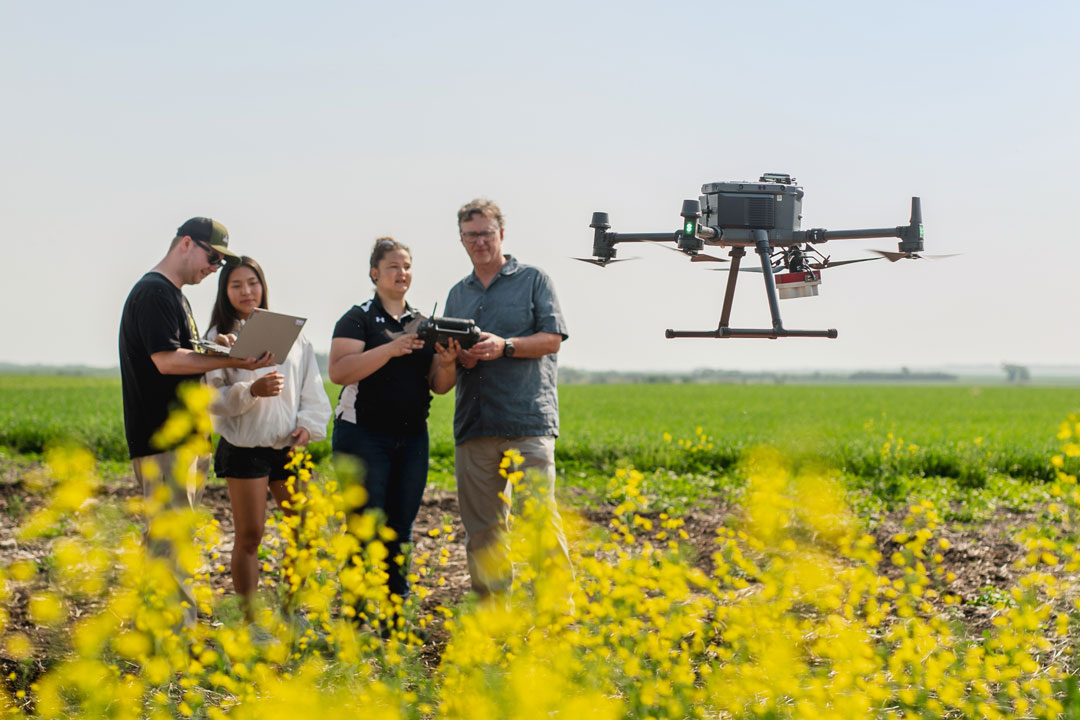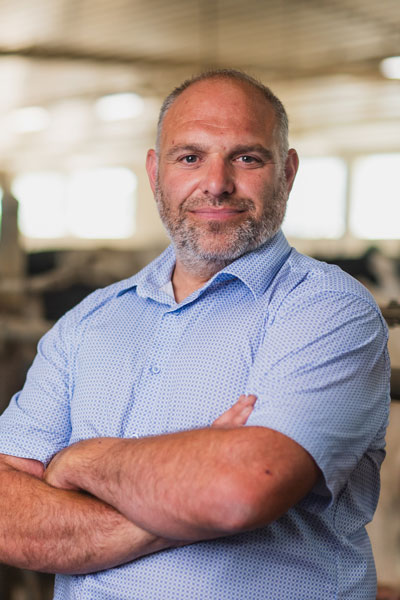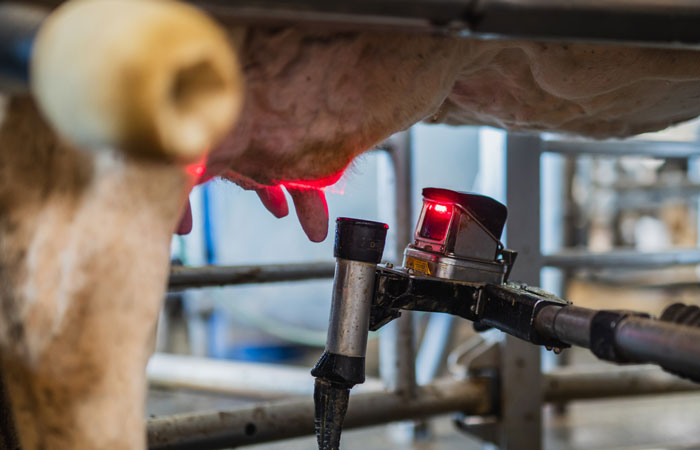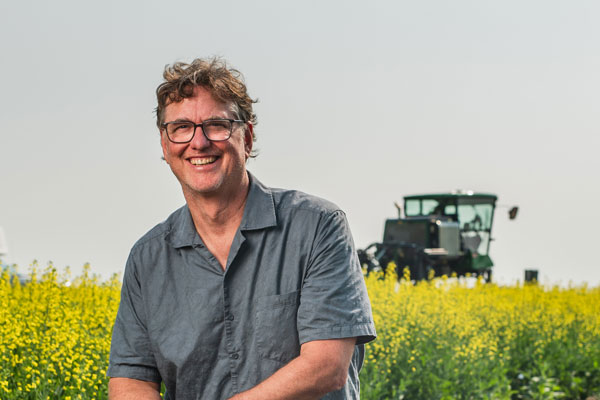
A new way to farm: Precision agriculture redefines research and technology
From using satellites thousands of kilometres above the Earth’s surface to examining chemical compositions in soils and plants, the goal of precision agriculture boils down to one word: efficiency.
By Matt Olson, USask Research Profile and ImpactAgricultural researchers are pushing beyond the boundaries of the exceedingly important but still “traditional” areas of crop and livestock study. Just as today’s sports science gives modern athletes an edge at every stage of preparation down to the molecular level, precision agriculture gives modern producers a never-before-seen edge when it comes to growing and raising plants and animals in an ever-changing environment.
Scientists at the University of Saskatchewan (USask) are casting their view beyond the field, to the edges of the atmosphere down to the most infinitesimal, to learn and understand more about what they can do to improve outcomes for farms and farmers, no matter their specialization.
“We’re getting more granular data, which we can use to guide more precise land management decisions – hence, precision agriculture,” said Dr. Preston Sorenson (PhD) of USask’s College of Agriculture and Bioresources. “But also with more granular data, we’re able to get much more accurate, scaled-up estimates.”
It’s not a new idea, or even a new term, but time leads to evolution and revolution – especially in the world of technology.
Precision agriculture means different areas of study to different scientists, but the overall goal is clear: using new technology to find new efficiencies in agricultural production.
Precision nutrition a tool of the future for livestock

Dr. Greg Penner (PhD) cares about what cows eat.
The idea of nutritional biology certainly isn’t new – humans have been developing various diets to best fit their lifestyles for a very long time – but putting it into play for dairy cows is becoming a much more refined process because the knowledge for nutrient requirements of cattle is more detailed than for humans.
A professor in the Department of Animal and Poultry Science, much of Penner’s research revolves around the idea of “precision nutrition” – meaning finding the most ideal and efficient amount of nutritional inputs to maximize animal health and outputs while minimizing waste products.
“We’re really focused on minimizing environmental losses while ensuring we’re delivering the right balance of nutrients to livestock to meet their nutritional requirements,” he said.
As the dairy industry continues to move towards more automated systems and individual cow data collection, there are more opportunities to gather data and provide optimized nutrition to individual animals.
As an example, robotic milking systems can precisely measure and predict a cow’s milking routine and milk production. Some of these robotic milking systems also measure body weight, milk quality, and the amount of fat and protein in the milk. All these factors can be used in early alert systems to identify sick cows and to help predict nutrient requirements. Those same machines can also dispense feed to the cow in a mixture that is specially formulated for that animal’s needs.
With steadily improving technology, Penner and researchers like him can draw more and more detailed info from the robotic systems and design feeding programs that target individual nutrition programs for each cow while minimizing the environmental impact.

“The robotic milking system knows who that cow is, it knows her predicted milk yield and it measures her actual milk yield,” Penner said. “Based on her seven-day average, it can predict how much milk she will deliver, and we tell the computer how to use that information to determine how much and what kind of extra supplement should be provided.”
As researchers find new avenues and new data sources to explore precision agriculture, Penner said one of the difficulties is determining which data is important. This will be an ongoing task as new devices are developed and marketed.
USask is not only at the cutting edge for agricultural research and technology, but as far as Penner is concerned it’s also the kind of institution that will help future researchers understand not only how to gather this kind of precise data, but how to best use it.
“We have a population of future producers that is a lot more comfortable with technology, and we’re giving them the opportunity to be aware of what type of data is available and to help guide the process for how they use that information to hopefully improve the sustainability of livestock agriculture,” Penner said.
“I wish we had many of these tools when I was still a livestock producer,” he added with a laugh.
Specific sciences in the soil

Deep in the soil, Dr. Sorenson is constantly discovering new ways to make life easier for producers.
“I do see soil as the foundation of human civilization,” he said. “So how we can better manage our soils is very important. We have increasing expectations of what we want our soils to do, in terms of sequestering carbon, having less greenhouse gas emissions, and ensuring our food security.”
As Penner’s work takes him deep into the biology of livestock, Sorenson’s research – as a research associate in the Department of Soil Sciences – delves down into the Earth. Sorenson’s definition of precision agriculture comes down to the myriad factors that affect soil, from nutritional components and outputs to crop rotations to chemical compositions and everything in between.
“I very much see precision agriculture being about trying to tailor your soil management and inputs to the variations in the landscape and soils within your fields, which can let us do a whole bunch of things,” he said.
One of Sorenson’s areas of research involves soil spectroscopy – analyzing the composition of soil using light-based tools.
Different compounds in the soil will absorb and reflect wavelengths of light to varying degrees, allowing for a snapshot of the most prevalent chemicals based on measurements of those wavelengths. While the technique may not be as exact as a chemical analysis in a lab, soil spectroscopy is weeks quicker than the “wet chemistry” process.
“It's speed, but it’s also huge potential cost savings,” he said. “What looks feasible with this technology is bulk soil properties, like carbon and clay content, because there’s enough of it there.”
But the biggest advantages in modern soil analysis come from using machine learning tools to combine all the different variables. By inputting data from in the field, in the lab, historical yield information and other observational sources like satellite imaging, an accurate picture of the field can be mapped.
If researchers put a limited number of soil sensors into the ground out in a field and get information of the chemicals present at each sensor, new predictive mapping technology can combine that on-the-ground data – or in this case, in-the-ground data – with those broader observations. Sorenson said they can create machine learning models to accurately interpolate the chemical composition in all the areas between the sensors.
Precision agriculture is an excellent tool for the future of agriculture – but as Sorenson puts it, it’s important to know how these tools fit into other tools and techniques to give producers the best advantages.
“It’s very much like a puzzle to be solved when it comes to data analysis,” he said. “How can I figure out how to work with this data and try to get a map that’s both useful and accurate?”Precision agriculture from satellite technology

Stretching from farmers’ fields to the upper atmosphere and back again, Dr. Steve Shirtliffe (PhD) has taken to space to find agricultural answers.
Or at least, the data he’s using comes from space – satellites scattered above Canadian farm fields gathering advanced imagery for Shirtliffe to process and analyze.
“People say to me ‘this is really cool, I want to know how I can get involved,’” Shirtliffe said. “We're just starting to scratch the surface of what we can do.”
Shirtliffe is a professor in the Department of Plant Sciences who specializes in the field of agronomy – a science that finds more efficient crop production solutions while also protecting the environment.
Shirtliffe is using satellite imaging to explore multifaceted field projects: to map and estimate greenhouse gas emissions like nitrous oxide from crop production; to chart the spatial variability of farm fields and how their yields differ over time; and the economic impacts of these types of projects.
But at the heart of all this research is a tremendous goal: “wall-to-wall” mapping of Prairie farm fields. Shirtliffe’s aim is to map long-term spatial variability in every single farm field in Western Canada, and then use artificial intelligence to determine the causes for that variability in fields.
“It’s crazy ambitious,” he said. “But we have this huge land mass of Western Canada, but we really don’t know that much about it. The best analogy I can use is it’s like sequencing a genome of a plant. This is the first step to really understanding, and it’s a huge undertaking in terms of the computational requirements of doing it.”

Thanks to geolocation devices on modern grain harvesters, producers can generate “yield maps” to measure how much is produced in different sections of the field. By combining that data with known environmental information and satellite imagery, Shirtliffe can use machine learning models to predict yield variability in a field.
And through using satellite imagery from multiple spectral bands and topographic analysis, Shirtliffe can map greenhouse gas emission hot spots in fields to better plan nitrogen fertilizer use and emission mitigation strategies.
“We can tell what fields, or what areas in the fields, should be prioritized to reduce nitrous oxide emissions and help Canada meet its greenhouse gas goals while still maintaining the ability to produce high-yielding crops,” he said.
These technologies and strategies are the future for those learning at USask as well. Shirtliffe is part of a group that has developed a brand-new Certificate in Precision Agriculture program at USask, passing this knowledge on to the next generation.
“In decades past, universities and colleges would teach agriculture students techniques like welding and hydraulics and … we had the emergence of some of the best no-till seeder companies that designed and built the tools farmers use today,” Shirtliffe said. “I’m hoping that this process of giving students and people in the agriculture community precision agriculture tools can do the same thing to catalyze this industry.”
Together, we will undertake the research the world needs. We invite you to join by supporting critical research at USask.

